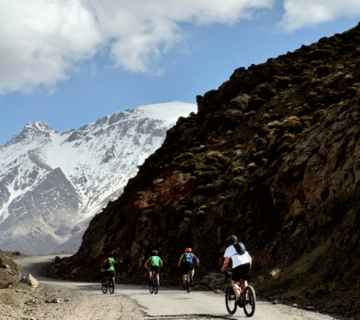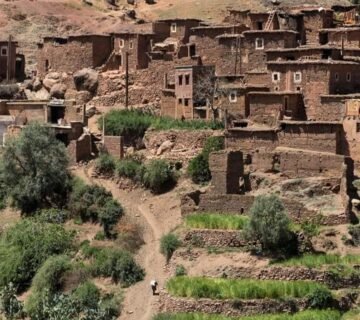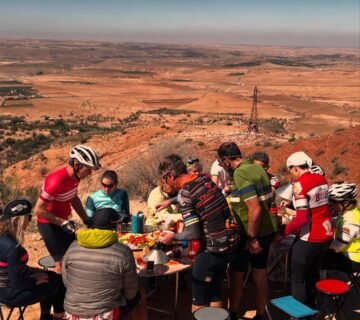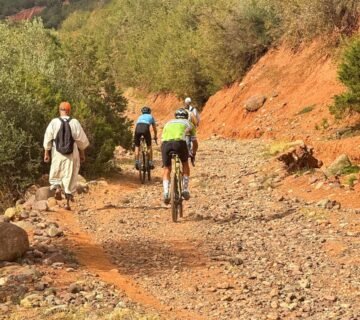Cycling in the Atlas Mountains
The Atlas Mountains rise dramatically across Morocco, stretching nearly 2,500 kilometers from the Atlantic coast to the edge of the Sahara. These rugged peaks are more than just a natural wonder — they are home to Amazigh (Berber) communities, centuries-old traditions, and some of the most exciting cycling routes in the world.
For travelers who dream of combining breathtaking landscapes with cultural encounters, cycling in the Atlas Mountains is an experience like no other. Whether you’re pedaling along gentle valleys, climbing steep mountain passes, or coasting through ancient caravan trails, every route offers new stories, new faces, and unforgettable scenery.
At MTB Morocco, we have dedicated years to guiding cyclists from all over the world into the heart of the Atlas. This guide explores everything you need to know: the best cycling routes, cultural highlights, practical tips, and why Morocco should be your next cycling destination.
Why Choose Cycling in the Atlas Mountains?
1. Diverse Terrain for Every Rider
The Atlas range offers something for all skill levels:
- Beginners can enjoy smooth roads through fertile valleys like Ourika or Aït Bouguemez.
- Intermediate riders can tackle rolling hills and mixed gravel paths around Ouirgane and the Kik Plateau.
- Advanced cyclists will love the high passes, with switchbacks that climb above 2,000 meters.
2. Cultural Encounters Along the Way
Cycling here means more than physical challenge. As you ride through Amazigh villages, you’ll encounter mud-brick kasbahs, children running beside your bike, and shepherds leading their flocks along narrow trails. These human connections transform a ride into a cultural immersion.
3. Year-Round Adventure
The High Atlas enjoys four distinct seasons. Snow-capped peaks in winter contrast with green valleys in spring and cool breezes in summer. Autumn paints the landscapes in golden colors. With careful route planning, cycling in the Atlas Mountains is possible almost all year.
Top Cycling Routes in the Atlas Mountains
🚴 Imlil to Toubkal National Park
- Level: Intermediate to Advanced
- Highlights: Stunning views of Mount Toubkal (4,167 m), the highest peak in North Africa.
- Why ride it: Perfect for riders seeking challenging climbs and the reward of panoramic landscapes.
🚴 Kik Plateau Loop
- Level: Beginner to Intermediate
- Highlights: Sweeping views of both the High Atlas peaks and the Agafay Desert.
- Why ride it: Great day trip from Marrakech, combining wide trails with cultural stops.
🚴 Ourika Valley Ride
- Level: Beginner
- Highlights: Waterfalls, riverside villages, and terraced fields.
- Why ride it: Easy, scenic, and full of authentic encounters with local families.
🚴 Tizi n’Tichka Pass
- Level: Advanced
- Highlights: Morocco’s most famous mountain pass, reaching 2,260 meters.
- Why ride it: A bucket-list climb for road cyclists, with jaw-dropping switchbacks.
🚴 Aït Bouguemez Valley
- Level: Intermediate
- Highlights: Known as the “Happy Valley,” with fertile farmland and red-earth mountains.
- Why ride it: Remote and authentic, offering pure Amazigh hospitality.
What to Expect on an MTB Morocco Cycling Tour
- Professional Guides – Experienced riders with deep local knowledge.
- Custom Routes – Tailored itineraries for your fitness level and travel goals.
- High-Quality Gear – Reliable mountain and road bikes, plus helmets.
- Cultural Stops – Meals with Amazigh families, tea in mountain homes, and visits to historic kasbahs.
- Full Support – Vehicle assistance for longer routes and gear transportation.
Practical Tips for Cycling in the Atlas Mountains
- Best Season: Spring (March–May) and autumn (September–November) are ideal.
- Fitness Preparation: Expect climbs! Train with hills before your trip.
- Hydration & Nutrition: Carry plenty of water; villages are far apart in high routes.
- Respect Local Customs: Dress modestly, greet villagers with “Salam Alaikum,” and always ask before taking photos.
- Pack Light but Smart: Sunglasses, gloves, sunscreen, and layers for changing weather.
Cultural Highlights Along the Routes
- Kasbahs & Fortresses: Ancient mud-brick fortifications, some dating back centuries.
- Local Markets: Weekly souks where villagers trade everything from spices to livestock.
- Traditional Cuisine: Refuel with tajine, couscous, and the ever-present mint tea.
- Festivals: If your ride coincides with a village festival, expect music, dance, and warm hospitality.
Frequently Asked Questions (FAQ)
Q: Can beginners really cycle in the Atlas Mountains?
Yes! With proper guidance and route selection, even first-time riders can enjoy gentle rides in valleys and foothills.
Q: Do I need to bring my own bike?
We provide high-quality bikes, but if you have a favorite, you’re welcome to bring it.
Q: How long should I plan for a cycling trip?
From half-day rides near Marrakech to week-long expeditions, options are flexible. Many travelers combine a short tour with other activities in Morocco.
Q: Is it safe?
Absolutely. With a professional guide and support, cycling here is safe and deeply rewarding.
Conclusion
Cycling in the Atlas Mountains is not just an activity; it’s a journey into Morocco’s heart. From steep climbs to rolling valleys, every ride is enriched with culture, history, and breathtaking scenery. At MTB Morocco, we craft tours that blend physical adventure with authentic encounters, ensuring every rider leaves with stories worth sharing.
👉 Book your Atlas cycling adventure today with MTB Morocco, and discover why riders from around the world fall in love with Morocco’s mountains.







No comment